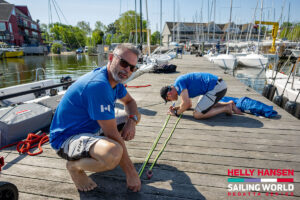
One evening a few years ago I had the opportunity to drive a J/24. I had logged countless hours as a tactician and bowman on the boat, but I’d never helmed it. I finally appreciated why J/24 skippers are so batty: they can’t see anything. We did well in that race, though it wasn’t because of my driving skills. I had confidence in each person doing their job, and focused on trying to keep my act together. I was the new guy, while the rest of the crew had a lot of time together, so their communication and trust level were high.
I’ve been fortunate enough to race in a lot of different classes in varying roles. While I’ve been able to develop relatively deep expertise in some positions on certain boats, I think some of the most valuable lessons I’ve learned have come through switching roles. There are high-level requirements to be consistently successful as a crew, no matter what position. In addition, we tend to execute our deep expertise skills unconsciously, while letting some of the more general best practices slip.
1. Get physical
Regardless of the physical demands of your primary ride or position, it always pays to be in good shape. Being physically fit improves mental focus, especially as the day and/or week wears on. Out-of-shape sailors are slow to recover when things go wrong. Maintaining a reasonable baseline of fitness makes it easier to change your weight as necessitated by different boats, without sacrificing your health. This opens up more opportunities.
2. Be prepared
Be sure to glance at the forecast before leaving the house. Only bring gear you anticipate wearing, but make sure you’ll be warm and comfortable. Always bring a watch and a roll of electrical tape, regardless of position.
3. Don’t Delay
Start racing when you get to the boat. There’s always something to do: start rigging, prep sails, organize down below, etc. If something’s wrong, or missing, you’ll catch it early and give your team time to rectify the situation.
4. Sort it out
Adding one new person to a crew creates a completely new team. Take the time to get everyone on the same page for the key maneuvers. Determine how the in-race communication should flow, what the tactician and helmsman want to hear. Then get to the racecourse early and practice.
5. Play your role
Great teammates bring out the best in everyone else, creating a whole that is greater than the sum of the parts. Trust your teammates so that you can focus on doing your job. Don’t hesitate to point out something that looks wrong, but make sure your area is locked down before you venture outside of it. The trimmer who watches the bowman’s every move isn’t looking at his sail enough.
6. Adapt
Ever find yourself saying: “I can’t believe we’re still going this way,” or “Why on earth did we tack there?” These thoughts are useless. You might not always agree with the tactician or the driver, but save the debate for later. Adapt to whatever call is made, and focus what you can do to make the best of the current situation.
7. Be proactive
The more you correctly move your weight before the skipper asks, the more your team is gaining. Upwind in lighter air, listen to the calls for puff and lull and slide your weight in and out accordingly. Downwind, crew weight is an effective way to steer the boat. If the trimmer feels light, slide to leeward to head up. If there’s a puff, press to weather to head down.
8. Communicate
When operating outside your standard playbook, step up the communication. For instance, to handle a particularly nasty set of waves, a trimmer might say: “I’m easing a lot for this set of waves.” This is better than the skipper asking: “Did you just ease a lot?” If you need to go to leeward, or to the bow, to fix something in full-hike conditions, make sure everyone is aware before you move. Allow the driver to pick the best time for you to go.
9. Thick skin Get one.
Skippers will snap occasionally. Their anxiety level often correlates to their limited view of the course. Snapping back only makes matters worse. Focus on fixing things and doing your job. Don’t take it personally, and stay confident in your capabilities.
10. Debrief
Regardless of your finish, it’s useful to break down what worked and what didn’t in each race. Frame the issue into something specific that you can improve on. For instance, a bowman might ask: “Am I not being loud enough on the line? It seemed we pulled the trigger well after I called that we were late.” When discussing tactics or strategy, avoid arguments and finger pointing. The last race is history; the key is how you can use that experience going forward. For instance, you could summarize a first beat as such: “It seems like all the top boats started at the pin and worked the left. Was that a fluky shift or something persistent that will make it the winning formula today?”
11. Take ownership
Whatever your role on a boat, you can’t be along for the ride. You have to own your space and minimize the need for direction. If you’re responsible for the vang, it has to automatically come off in the lulls and on in the puffs. If someone calls for the vang halfway into a puff, you’ve already lost valuable distance. Trimmers must own their sail. On boats that require very active jib trim, I use the crew weight as a trigger. Any condition change warranting significant crew weight movement necessitates a sail adjustment. On a Lightning, if I go from the cockpit to hiking, I’ll put on jib halyard, move the lead back, and adjust the sheet.
12. Check out the competition
We all have moments when the boat just isn’t going that well. The ability to quickly diagnose and correct is vital. Before reinventing the wheel, look for differences in nearby boats that are going well. It might be something as apparent as a different angle or more heel.
13. Know the plan
Race results are largely influenced by how you handle mark roundings—first there is the tactical call of the approach, then there is the execution of the plan. The tactics won’t matter if people are unsure of the plan or the call comes too late. This is most critical for the bowman, because of the physical separation to the call makers and the ramifications of a breakdown on the bow. When in doubt, pass the information up the rail in a calm manner. In addition, the bowman has to take charge if things are coming down to the wire. He or she ultimately has the best sense of what can and cannot be done in time, and has to be willing to say: “You need to make a call now.”









